Input interpretation

acetamide | molar mass
Result

Find the molar mass, M, for acetamide: M = sum _iN_im_i Plan: • Write the chemical formula and gather atomic masses from the periodic table. • Determine values for N_i and m_i using these items. • Finally, compute the mass. Write the chemical formula: CH_3CONH_2 Use the chemical formula, CH_3CONH_2, to count the number of atoms, N_i, for each element: | N_i C (carbon) | 2 H (hydrogen) | 5 N (nitrogen) | 1 O (oxygen) | 1 Look up the atomic mass, m_i, in g·mol^(-1) for each element in the periodic table: | N_i | m_i/g·mol^(-1) C (carbon) | 2 | 12.011 H (hydrogen) | 5 | 1.008 N (nitrogen) | 1 | 14.007 O (oxygen) | 1 | 15.999 Multiply N_i by m_i to compute the mass for each element. Then sum those values to compute the molar mass, M: Answer: | | | N_i | m_i/g·mol^(-1) | mass/g·mol^(-1) C (carbon) | 2 | 12.011 | 2 × 12.011 = 24.022 H (hydrogen) | 5 | 1.008 | 5 × 1.008 = 5.040 N (nitrogen) | 1 | 14.007 | 1 × 14.007 = 14.007 O (oxygen) | 1 | 15.999 | 1 × 15.999 = 15.999 M = 24.022 g/mol + 5.040 g/mol + 14.007 g/mol + 15.999 g/mol = 59.068 g/mol
Unit conversion

0.05907 kg/mol (kilograms per mole)
Comparisons

≈ ( 0.082 ≈ 1/12 ) × molar mass of fullerene ( ≈ 721 g/mol )

≈ 0.3 × molar mass of caffeine ( ≈ 194 g/mol )

≈ 1.01 × molar mass of sodium chloride ( 58.443 g/mol )
Corresponding quantities

Mass of a molecule m from m = M/N_A: | 9.8×10^-23 grams | 9.8×10^-26 kg (kilograms) | 59 u (unified atomic mass units) | 59 Da (daltons)

Relative molecular mass M_r from M_r = M_u/M: | 59